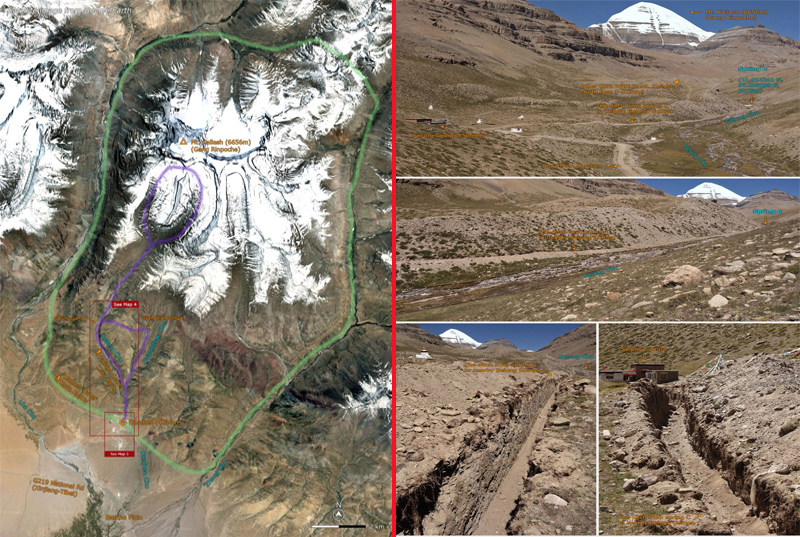Tuesday, 19 July 2016 10:26 Steve Shaw, Tibet Post International

(Photo 1) Map around Mt. Kailash and (Photo 2) The ditch from Spring C to nearby Selung Gompa
Photos taken in late September 2015.
Photo: File
London — New evidence has revealed that a Chinese company is making large profits through bottled mineral water originating from underground water extracted from Mount Kailash, one of Tibet’s highest mountains and a site sacred to four religions.
Since 2014 the Darchen Mineral Water Factory has been operated by Chinese company Mt. Kailash Food & Beverage and has been steadily increasing its operations, with water extracted primarily from an area 6km south of Mt. Kailash.
An investigation by Kailash Environment Observer found that the recent factory developments are visible through satellite imagery on Google Earth. Between 2005 and 2013 there are no obvious operations taking place, however a photo taken in June 2014 shows signs of significant upscaling.
This includes a water pipeline, which runs from the rear-side of the factory to the mountain for water intake. All produced bottle waters, appears to be sourced from three underground springs in the Selung River.
Overexploitation of these water intakes threatens to cause significant damage the fragile natural environment. It also poses a risk to the mountain itself, which is regarded as a sacred site to Buddhism, Bon, Hinduism and Jainism. In Hinduism Mount Kailash is home of Lord Shiva, one of the most powerful deities.
The impact of the developments at Darchen have been felt by the locals and Tibetan pilgrims. Darchen often acts as the starting point for pilgrimages in the region, however these have been disturbed by noise pollution. Meanwhile, a drainage hose at the rear of the factory appears to be discharging waste water into the local river.
In line with the upscaling of the Darchen Mineral Water Factory, an initiative called “Sharing Tibet’s Water with the world” was implemented in 2014 by the regional government of the Tibet Autonomous Region (TAR). Under a ten-year plan announced in November 2015 the initiative hopes to see the bottled water industry in Tibet grow to 10 million tonnes of bottled water production by 2025.
Companies are being encouraged to take advantage os Tibet’s water resources through significant tax breaks and lower water extraction fees than elsewhere in China.
Free Tibet recently launched a campaign to bring global awareness to the dangers of the bottled water industry in Tibet, which is expanding with little regard for environmental consequences or the rights of the Tibetan people. The group says that there is currently a “gold rush” for Tibetan water and the industry has grown to include Western companies as well as Chinese.




 Print
Print Email
Email